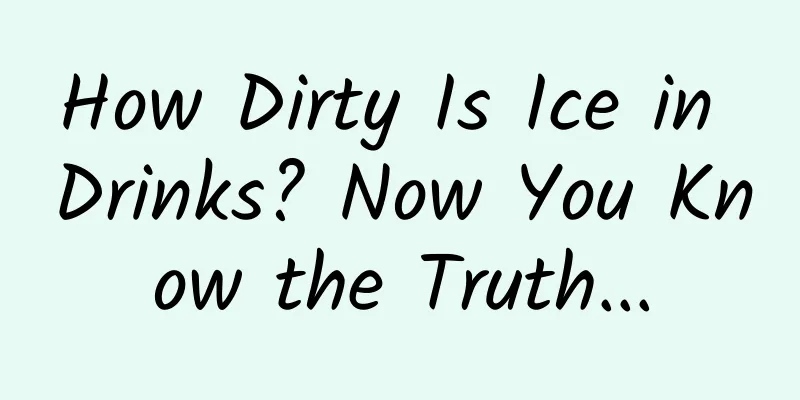How Dirty Is Ice in Drinks? Now You Know the Truth...

|
The temperature has been over 40 degrees Celsius lately, and you're almost going to melt in the heat when you go out. At this time, a glass of iced drink can always save you from the fire. Why do iced drinks taste so good? On the one hand, low temperatures can enhance the tongue’s perception of sweetness[1]. On the other hand, if fructose is used in the drink, low temperatures can increase the sweetness of the fructose, making the iced drink taste sweeter. However, while you are enjoying the coolness, there is an even more chilling news to tell you - the ice in your drink may actually be quite dirty. Food safety incidents caused by unclean ice in beverages Other studies have found that the total number of colonies in milk tea with ice is significantly higher than that in milk tea without ice . Image source: Reference [2] What makes ice in drinks so dirty? Possible contamination pathways for beverage ice When it comes to ice cubes, we usually think it is relatively clean because in our simple concept, low temperature is not conducive to the reproduction of bacteria and viruses. However, the fact is that there are many ways for ice cubes used in beverages to be contaminated , not just limited to whether there are bacteria and viruses in the water used to make ice cubes. It can even be said that there are many reasons for ice cube contamination that you can't imagine. 1. The water source for making ice is unsanitary In order to ensure the hygiene and safety of ice cubes, according to the provisions of the National Food Safety Standard for Frozen Beverages and Ingredients (GB 2759-2015), ice-making water should be sterilized and safe drinking water . However, not every business is willing to spend money and time to select qualified ice-making water. If there are microorganisms in the ice-making water , there is a high probability that the total number of bacteria in the ice produced will exceed the standard and there will be pathogenic bacteria or viruses. Although low temperature is not conducive to the reproduction of microorganisms, it does not necessarily kill existing microorganisms. When consumers eat pathogenic microorganisms in ice cubes, the microorganisms will begin to reproduce in their bodies and eventually cause illness. Copyright images in the gallery. Reprinting and using them may lead to copyright disputes. 2. Ice making, ice transport and storage equipment are contaminated If the exterior and interior of the ice machine are not cleaned and disinfected regularly as required , it is easy for dirt to accumulate. At the same time, we see that many businesses often leave ice containers open for easy access, which greatly increases the risk of contamination by bacteria and other microorganisms, and even cockroaches, mosquitoes, flies, etc. At the same time, if the containers for transporting ice cubes and the ice shovels are not stored properly or are not cleaned and disinfected in time, contaminants can easily be introduced into the ice cubes. 3. The ice cubes are not edible Although this situation is rare, there have been news reports that some unscrupulous merchants used ice cubes for storing fish, shrimp and seafood as beverage ice cubes in order to "make the best use of it". This kind of ice cubes may contain bacteria, viruses, parasites, etc., which is extremely dangerous. Therefore, it is not an exaggeration to say that ice in drinks is dirty. When we buy drinks, we sincerely recommend not adding ice, which not only protects our health and safety, but also allows us to drink more drinks. After all, adding ice to drinks will definitely take up a lot of space (adding more ice and less drinks, the merchants are smart enough). When ordering milk tea, you will often see the message "less ice (not full cup)" What should I do if the ice in my drink is so dirty and I still want to drink it cold? Although adding ice has risks, some friends still want to drink ice-cold drinks because of habit and preference. How can this problem be solved? On the one hand, we can try to minimize the food safety risks of iced drinks, and on the other hand, we can also collect some tips to make drinks taste good even without ice. To reduce the chance of eating contaminated ice, you can do this : 1. Make your own ice cubes at home Make your own ice cubes at home, carry ice cubes in a thermos when you go out, and add them to the drinks you buy. 2 Choose a store that appears to have better hygiene When buying iced drinks, pay attention to whether the store's ice containers are clean and sealed ; whether the store clerks wear disposable gloves when taking ice, whether the ice shovels are stored in clean and hygienic special containers , etc. Choose a store that does a relatively good job in these aspects. Copyright images in the gallery. Reprinting and using them may lead to copyright disputes. If you want to make your drink taste good without ice, you can do this : 1 Add a few mint leaves The menthol in lotus can stimulate the cold receptors on the nerve endings of the human body, making people feel the loss of heat and feel more refreshed. 2. Add sweet fruits to increase sweetness Since low temperature can increase the refreshing feeling by increasing the sweetness, we can certainly add some sweet fruits, such as grapes, watermelons, etc. , to the drink to improve the taste. Although it is not icy enough, it is delicious enough. A little trick: quickly cool down drinks without adding ice cubes If it is not convenient to buy refrigerated drinks, you can try wrapping the drink with a wet paper towel or towel and putting it in the freezer . You can quickly get a chilled drink in a few minutes. Image source: Weibo screenshot Looking back on our childhood, we didn’t have the conditions to drink ice drinks often, but eating the big watermelons that my mother soaked in a basin of cold water and the peaches washed in well water, accompanied by a glass of boiled water, could also quench our thirst and relieve the heat. Nowadays, we have the conditions to drink a variety of cool drinks, so we should try to make them both cool and healthy. References [1]Cruz, A., Green, B. Thermal stimulation of taste. Nature 403, 889–892 (2000). [2] Yang Lu, Zhao Aifei, Zhu Junli. Investigation and analysis of microbial content in commercial milk tea drinks[J]. Anhui Agricultural Sciences, 2015(1):251-253,304. Planning and production Author: Wang Lu, Chinese registered nutritionist, Master of Public Health, Peking University Review|Chen Ran, Associate Research Librarian (Science Communication) / Senior Engineer, COFCO Nutrition and Health Research Institute |
<<: Dolphin: What just got into my head?
>>: What is a sonic boom? Is it dangerous?
Recommend
Xing'an League Mini Program Development Company, how much does it cost to develop an educational mini program?
The factors affecting the quotation of Xing'a...
Xiaohongshu promotion and operation plan!
At the beginning, my purpose of operating Xiaohon...
It’s popular! Apple App Store's search associative word function appears to have been hacked, pointing to the Yicai.piao website!
Qinggua Media News: In the early morning of Janua...
Liu Zuohu takes a different approach to ROM to prove that he knows more than just hardware
[[130949]] "In 2014, OnePlus's mobile ph...
Where can Ningbo students drink and taste tea? I'll tell you
Recommended places for drinking tea and spa in Ni...
Google demonstrates using Dart to develop Android applications
[[133243]] Google developers tried to develop app...
What mobile phones are used in other countries? See the market share distribution chart to find out
This is an era of data interconnection and smartp...
Programmer's own ability expansion model
[[142043]] I heard someone say a word called “Com...
Hot selling product? 2 public traffic pools, 8 ways to divert traffic!
Do you believe it? Everything in the world will g...
How to place advertisements on Toutiao?
How to place ads on Toutiao? Advertising Process ...
The "Exploration No. 1", which once caught lionfish and hook shrimp in the deep sea of 10,000 meters, has completed a new mission
On the afternoon of January 26, the "Explora...
Microsoft Office iOS / iPadOS version upgraded to a new design: a lot of rounded UI, light background buttons
[[440046]] On December 13, according to feedback ...
14 new confirmed cases in Beijing! In which specific areas are they distributed? Attached is the latest epidemic situation!
According to the latest data released on the offi...
After school starts, two diseases are prevalent, parents must pay attention →
After the spring semester begins, hand, foot and ...
Most blockchain projects are still "air", but stock prices have already started to go wild
While virtual currencies such as Bitcoin are stil...









